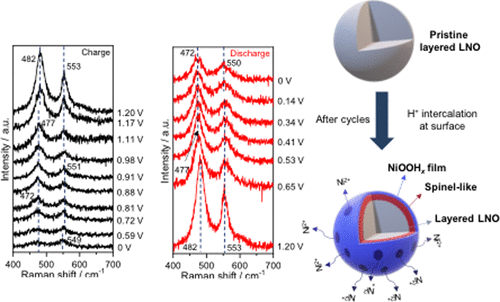当前位置:
X-MOL 学术
›
ACS Appl. Mater. Interfaces
›
论文详情
Our official English website, www.x-mol.net, welcomes your
feedback! (Note: you will need to create a separate account there.)
Mechanism of the Loss of Capacity of LiNiO2 Electrodes for Use in Aqueous Li-Ion Batteries: Unveiling a Fundamental Cause of Deterioration in an Aqueous Electrolyte through In Situ Raman Observation
ACS Applied Materials & Interfaces ( IF 8.3 ) Pub Date : 2020-12-01 , DOI: 10.1021/acsami.0c18157 Changhee Lee 1 , Yuko Yokoyama 1 , Yasuyuki Kondo 1 , Yuto Miyahara 1 , Takeshi Abe 1 , Kohei Miyazaki 1
ACS Applied Materials & Interfaces ( IF 8.3 ) Pub Date : 2020-12-01 , DOI: 10.1021/acsami.0c18157 Changhee Lee 1 , Yuko Yokoyama 1 , Yasuyuki Kondo 1 , Yuto Miyahara 1 , Takeshi Abe 1 , Kohei Miyazaki 1
Affiliation

|
This study investigated the fundamental mechanisms of the loss of capacity of LiNiO2 (LNO) electrodes for Li+ insertion/deinsertion with a special focus on the origin of this deterioration in an aqueous system. In situ Raman spectra revealed that the intercalation of H+ ions formed a NiOOHx film at the surface of LNO during the initial electrochemical cycles; this NiOOHx film was also confirmed by X-ray photoelectron spectroscopy and transmission electron microscopy analysis. The formation of an electrochemically inactive spinel-like phase (Ni3O4) at the subsurface was triggered by the absence of Li in the NiOOHx film at the surface. These structural changes of LNO, accelerated by the intercalation of H+ ions, were considered to be the fundamental cause of the greater loss of capacity in the aqueous system.
中文翻译:

用于水性锂离子电池的LiNiO 2电极容量损失的机理:通过原位拉曼观察揭示水性电解质劣化的根本原因
这项研究调查了LiNiO 2(LNO)电极用于Li +插入/插入的容量损失的基本机理,特别关注了水性系统中这种劣化的起因。原位拉曼光谱表明,在最初的电化学循环中,H +离子的插入在LNO表面形成了NiOOH x膜。通过X射线光电子能谱和透射电子显微镜分析也证实了该NiOOH x膜。NiOOH x中不存在锂会触发在表面下形成电化学惰性的尖晶石状相(Ni 3 O 4)。膜在表面。通过插入H +离子而加速的LNO的这些结构变化被认为是水性系统容量损失更大的根本原因。
更新日期:2020-12-16
中文翻译:

用于水性锂离子电池的LiNiO 2电极容量损失的机理:通过原位拉曼观察揭示水性电解质劣化的根本原因
这项研究调查了LiNiO 2(LNO)电极用于Li +插入/插入的容量损失的基本机理,特别关注了水性系统中这种劣化的起因。原位拉曼光谱表明,在最初的电化学循环中,H +离子的插入在LNO表面形成了NiOOH x膜。通过X射线光电子能谱和透射电子显微镜分析也证实了该NiOOH x膜。NiOOH x中不存在锂会触发在表面下形成电化学惰性的尖晶石状相(Ni 3 O 4)。膜在表面。通过插入H +离子而加速的LNO的这些结构变化被认为是水性系统容量损失更大的根本原因。















































 京公网安备 11010802027423号
京公网安备 11010802027423号